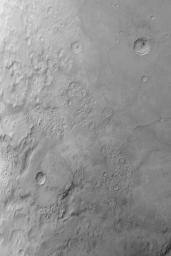
|
Hellas Planitia
- Click the image above for a larger view
- Full-Res JPEG (1187 x 1780) (214.7 kB)
- Full-Res TIFF (1187 x 1780) (2.0 MB)
Caption:
MGS MOC Release No. MOC2-471, 2 September 2003
Hellas Planitia is the floor of a giant basin that originally formed by the impact of a large comet or asteroid at a very early time in martian history. Throughout most of the martian year, Hellas is a difficult target for the Mars Global Surveyor (MGS) Mars Orbiter Camera (MOC) because it is often dusty and cloudy. The best time of year to observe Hellas Planitia occurs during the southern autumn season. The most recent best-time-of-year for Hellas imaging occurred in September and October 2002. This is a wide angle red camera image obtained in October 2002 that shows a large portion of Hellas Planitia at a scale of about 245 meters (268 yards) per pixel. The image covers an area about 290 km (180 mi) wide. Sunlight illuminates the scene from the upper left.
Cataloging Keywords:
| Name | Value | Additional Values |
|---|---|---|
| Target | Mars | |
| System | ||
| Target Type | Planet | |
| Mission | Mars Global Surveyor (MGS) | |
| Instrument Host | Mars Global Surveyor | |
| Host Type | Orbiter | |
| Instrument | Mars Orbiter Camera (MOC) | |
| Detector | ||
| Extra Keywords | Asteroid, Comet, Dust, Grayscale, Impact | |
| Acquisition Date | ||
| Release Date | 2003-09-05 | |
| Date in Caption | 2003-09-02 | |
| Image Credit | NASA/JPL/Malin Space Science Systems | |
| Source | photojournal.jpl.nasa.gov/catalog/PIA04723 | |
| Identifier | PIA04723 | |
